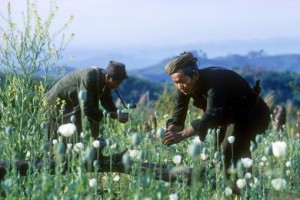Latest Opium Cultivation Figures for Burma Maintain Worrying Status Quo
By Burma Partnership • November 5, 2012 A UN Office on Drugs and Crime report released last week reveals that opium cultivation has increased in Burma for the sixth consecutive year. In 2012 there will be an estimated 690 tons of opium grown in the country, a 17% increase from last year and double that of six years ago.
A UN Office on Drugs and Crime report released last week reveals that opium cultivation has increased in Burma for the sixth consecutive year. In 2012 there will be an estimated 690 tons of opium grown in the country, a 17% increase from last year and double that of six years ago.
Poverty, caused by the inability of people to participate in sustainable livelihoods due to armed conflict and repression is a causal factor for this increase in opium cultivation. There has been much focus on Burma over recent political developments, the release of political prisoners and the easing of media restrictions. However, there has been very little focus on the lack of alternatives for people living in the conflict areas of Shan and Kachin States, where the majority of opium production occurs. There is a direct link between ongoing conflict and opium cultivation. “There is no question that there is a strong connection between the conflicts in the country and the most immediate sources of revenue to purchase weapons, and in many instances this is both opium and heroin and methamphetamine pills,” says Gary Lewis, the United Nations Office on Drugs and Crime regional representative.
Protests in Rangoon and Mandalay over land confiscations and media restrictions do and should get attention. What gets much less attention are the choices faced by farmers in Shan or Kachin states. The government has a stated goal of eradicating all opium cultivation by 2014, and they are systematically burning crops and punishing those caught growing opium. Yet at the same time, local officials encourage cultivation, opium being the only crop that generates enough income to pay the “taxes” required by the military. With citizens having to pay taxes to both the Burma Army and ethnic armies, there is one crop valuable enough to enable this and it is not rice.
“If you don’t grow, how else can you have money to feed us, the Burmese army and the Shan rebels?” one militia officer in eastern Shan State reportedly told villagers.
Seventy percent of the opium produced in South East Asia goes directly to China for domestic consumption. As a result China has implemented an Opium Substitution Program. Ostensibly this is to provide farmers with alternatives; realistically it has resulted in large Chinese businesses controlling large tracts of land in Shan and Kachin States. The huge increase in Chinese agricultural concessions in northern Burma is directly driven by China’s opium crop substitution program, offering subsidies, tax waivers, and import quotas for Chinese companies.
Opium production has increased because of poverty, armed conflict and a lack of alternatives. It’s both encouraged by the Burma Army and deemed a punishable offense. The programs for eradication increase foreign control over large parts of Shan and Kachin States and as the UN report clearly states, these programs have not worked.
Opium production is a marker; a marker of the availability of sustainable livelihoods, a marker of real development not the development measured by laws passed or statements made but actual development of the citizens of Burma.
Real development is about what choices are available: the choices available not to high profile political figures but to average citizens, what choices are available to provide food, health care and shelter for one’s family and what risks one has to take to put one’s children in school. By this measurement there is a huge lack of alternatives for the people of Burma and a lack of sustainable development.
Tags: Burma Partnership, Opium, United Nations Office on Drug and CrimeThis post is in: Blog
Related PostsBurma Partnership Celebrates Continuing Regional Solidarity for Burma and Embraces the Work Ahead for Progressive Voice
Burma Army Displays Blatant Disregard for 21st Century Panglong Peace Process
Ann Din Coal Power Plant: Local Movement and Action to Preserve and Protect Natural Resources and Land: Mon IDP Report Case Study #4
Latest Human Rights Abuse Case Demonstrates Urgent Need to Reform the Myanmar National Human Rights Commission
Human Rights Far From Guaranteed as US Sanctions on Burma Are Removed









 All posts
All posts